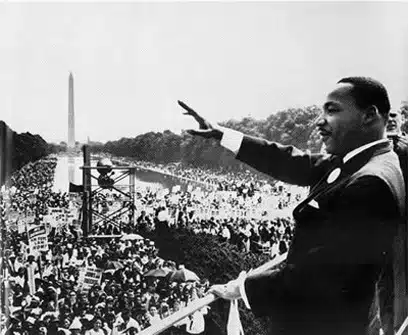If you break the speech down technically, its quality and motivational aspects has a great deal to do with tone. Tone reflects our mood when communicating. We know Dr King’s mood was one of passion and dreams because his tone is so beautiful. The effect is almost like singing.
If you set the right tone, have a clear purpose, and are focused on your audience, it’s more likely that the presentation or message will be received in the way it was intended.
Jennifer Logue – Working Voices
Try asking yourself when preparing a presentation “What is the tone of my message?” Do I want to inspire? Do I want to soothe? Do I want to motivate?
By asking these questions you can bring the right amount of mood to the presentation and stand the best chance of getting your audience to take the action you want.
Let’s take a look at the speech now in a little more detail because as communicators and leaders there is still so much we can learn from it. The world stopped and listened on August 28, 1963 as Dr. Martin Luther King, Jr gave his “I Have a Dream” speech.
You may not be talking about such an earth-shattering subject but what we can do is learn from this to ensure any presentation you give follows the same formulae for being impactful.
Absolute focus
This was not blue-sky thinking or an overview – the speech has clear purpose. In reality, the message for the speech can be covered in only one or two sentences. If you have a desired outcome, all your rhetoric needs to aim, like a laser, to that outcome.
Emotional content
Dr King makes use of emotive words, his tone is undulating and his language rich in visual imagery. His aim is to clearly outline but also to persuade us to change our minds. We are driven by much more than facts, engage the audiences’ feelings. We can see in this speech clear uses of energy and enthusiasm that keeps the audience hanging on his every word.
Content flow
It is a clear path the speech follows, Dr King looks and guides us along the past, the present and his “dream” of the future. Like any good story, a presentation needs a flow and keeping it simple in terms of where you have been (or are coming from), where you are now and what the end point it means your presentation will have a natural route to follow. You then don’t end up meandering off and confusing the audience.
A beginning, middle and an end, it’s what all stories should have to allow us to make sense of them.
Reinforcement
The more we hear something, the more likely it is to sink past out busy minds and into our brains, and such is the power of repetition.
In the speech key phrases are repeated – not just the famous “I have a dream” but also “now is the time”.
Visual language
The speech does not have to reply on presentation slides, D King uses emotive and visual language to paint a picture that the audience can literally see in their minds eye.
The human brain makes an image from a word to make sense of it. If I tell you NOT to think of a pink whale, your mind has to create that image in order to NOT think about it.
Short is beautiful
The human mind is an amazing computer and we can keep focused for only very short spaces of time without being distracted – about 10 minutes is maximum concentration time so waxing lyrical on an important subject should be avoided.
Get clear and keep to the point. The shorter the talks or presentation, the more powerful it tends to be. If you have to fill up 30 minutes or more, keep the most relevant parts at high energy with very visual language to keep or re-engage your audience at those crucial times.
Closing the speech
We already mentioned a beginning, middle and an end. The end is where you need to wrap everything back together. Like a sales close, this is where you reinforce key points, repeat what is necessary or important and reconnect with your audience.
There is a fascinating video, which is an interview with Dr. King’s speechwriter. It is only four minutes long and it gives more insights into what made this speech so very memorable and powerful.





